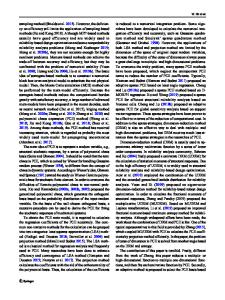Design sensitivity analysis with polynomial chaos for robust optimization
- PDF / 1,992,010 Bytes
- 17 Pages / 595.276 x 790.866 pts Page_size
- 96 Downloads / 345 Views
RESEARCH PAPER
Design sensitivity analysis with polynomial chaos for robust optimization Chengkun Ren 1 & Fenfen Xiong 1
&
Bo Mo 1 & Anik Chawdhury 1 & Fenggang Wang 1
Received: 22 May 2020 / Revised: 23 June 2020 / Accepted: 24 July 2020 # Springer-Verlag GmbH Germany, part of Springer Nature 2020
Abstract Polynomial chaos (PC) methods with Gauss-type quadrature formulae have been widely applied for robust design optimization. During the robust optimization, gradient-based optimization algorithms are commonly employed, where the sensitivities of the mean and variance of the output response with respect to design variables are calculated. For robust optimization with computationally expensive response functions, although the PC method can significantly reduce the computational cost, the direct application of the classical finite difference method for the analysis of the design sensitivity is impractical with a limited computational budget. Therefore, in this paper, a semi-analytical design sensitivity analysis method based on the PC method is proposed, in which the sensitivity is directly derived based on the Gauss-type quadrature formula without additional function evaluations. Comparative studies conducted on several mathematical examples and an aerodynamic robust optimization problem revealed that the proposed method can reduce the computational cost of robust optimization to a certain extent with comparable accuracy compared with the finite difference-based PC method. Keywords Robust design optimization . Polynomial chaos . Gauss-type quadrature . Design sensitivity
Nomenclature b Coefficients of polynomial chaos model d Dimension of design variables N Number of function evaluations m Dimension of random parameters E(•) Operation of calculation expectation f(x) Objective function g(x) Constraint function p Order of polynomial chaos model K Accuracy level of sparse grid x Random design vector x Random design variable q Random parameter vector
Responsible Editor: Erdem Acar Electronic supplementary material The online version of this article (https://doi.org/10.1007/s00158-020-02704-2) contains supplementary material, which is available to authorized users. * Fenfen Xiong [email protected] 1
School of Aerospace Engineering, Beijing Institute of Technology, Beijing 100081, China
q ω y(x) μ σ Φ φ DSA FDM FFNI MCS SGNI
Random parameter variable Gauss-type quadrature weight coefficient Output response Mean value Standard deviation value Multi-dimensional orthogonal polynomial One-dimensional orthogonal polynomial basis function Design sensitivity analysis Finite difference method Full factorial numerical integration Monte Carlo simulation Sparse grid numerical integration
1 Introduction The objective of robust design optimization is the optimization of the product performance while minimizing the sensitivity of the performance to uncertainties, which has been widely applied to aerospace engineering (Xiong et al. 2015a; Li et al. 2013; Wu et al. 2018), automobile engineering (Zhang et al. 2007), and civil
Data Loading...











